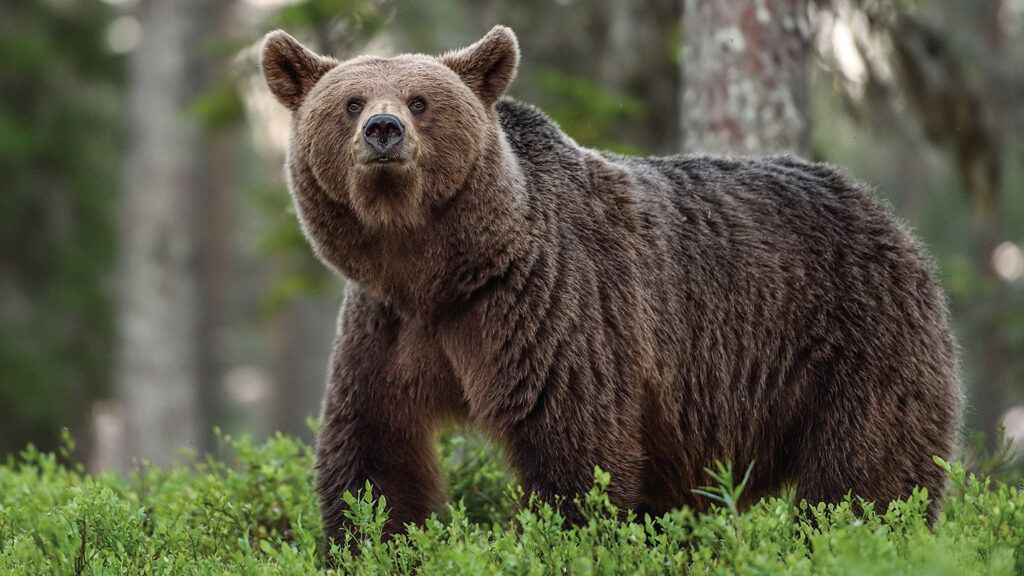One of the joys of hiking is spotting the wildlife around you. Do you know how to keep yourself safe while also respecting wild animals and their habitats? “For all wildlife,” says Leslie T. Sharpe, author of The Quarry Fox: And Other Critters of the Wild Catskills, “the first line of protection is to not startle or surprise them. It’s best to always watch ahead, and make some kind of noise so that they can hear you coming.” Here’s what to do if you encounter these animals out on the trail.
Black Bears
If you see a black bear ahead, keep your distance. This will allow the animal to carry on with its routine. If the bear spots you, don’t look it in the eye, Sharpe warns. “This is interpreted as a challenge.” Jessica Williams of Seattle, who hikes with her dachshunds, says it’s best to remain calm. “Unlike with a grizzly, avoid making yourself look threatening to a black bear. Instead, slowly back away. Don’t run, and never turn your back to the bear.”
If you’re worried bears might be nearby, keep them at bay by singing, clapping and banging sticks. Bear bells, whistles and alarms may also work. Carry bear spray and make sure you’re trained in how to use it.
Grizzly Bears
Grizzlies are a different story. They will try to intimidate you by false charging, Sharpe says. “Stand your ground, spread your jacket over your head and make yourself as big and tall as possible. If attacked, try to punch the bear in the nose. If it knocks you down, lie on your tummy, cover the back of your neck with your hands and don’t move. Hopefully, it won’t be hungry.”
Snakes
Even nonvenomous snakes can bite, so it’s best to give them a wide berth and wear leather boots to protect your feet. If you meet a rattlesnake, stay still and give it time to calm down, then back away.
If you’re planning to hike with dogs in rattlesnake territory, Amy Burkert of the travel website Go Pet Friendly recommends rattlesnake aversion training for the dogs, typically a six-week class to learn scent identification and an escape response.
Coyotes and Cougars
Never run or act like prey if you come across a coyote or a cougar. “Yell, wave your arms and maintain eye contact,” says avid hiker Kristine Tonks of Edmonton, Canada. If the animal is aggressive, throw your backpack in its direction.
Moose
Spot a moose? Don’t panic. These herbivores aren’t interested in you as prey. But if they begin to charge, run and hide. They can seriously maim with their powerful hooves.
Mountain Goats
Williams notes that encounters with aggressive mountain goats have prompted the closure of certain trails in Washington State. “Stay at least 50 yards away from a mountain goat,” she advises. “If a goat looks threatening, back away and yell to scare it.”
Alligators
Be alert for alligators when hiking along a waterway. Pamela Webster of Ithaca, New York, travels by sailboat with her husband and golden retriever. Her advice: “Never wade, or allow your dog to wade, in fresh or brackish water where alligators are likely to appear.” Especially at dawn and dusk, when gators are most active.
Being prepared and knowing how to react in these situations is key. Understanding how to protect wildlife while you’re in their territory is important too.
- While you may be eager to snap a picture, do not encroach on an animal’s space. Your presence could jeopardize its ability to remain safe from a predator.
- Consider keeping your dog on a leash. According to Parks Canada, off-leash dogs may chase wild animals or cause them to feel threatened, and are one of the leading causes of wild animal attacks.
- Never come between a wild animal and its young. Parental instinct will kick in and prompt an attack.
- Never feed wild animals, no matter how cute they look. Nonnative food may harm them, and feeding them might lead to frequent encounters, which could be dangerous.
Did you enjoy this story? Subscribe to All Creatures magazine.





